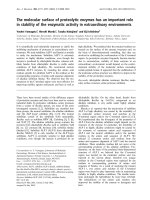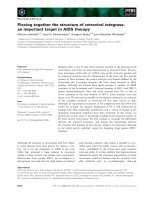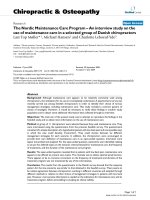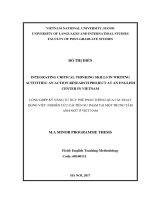2018 literature program – an important milestonea in the history of the development of high school curriculum in Vietnam
Bạn đang xem bản rút gọn của tài liệu. Xem và tải ngay bản đầy đủ của tài liệu tại đây (325.8 KB, 9 trang )
TRƯỜNG ĐẠI HỌC SƯ PHẠM TP HỒ CHÍ MINH
HO CHI MINH CITY UNIVERSITY OF EDUCATION
TẠP CHÍ KHOA HỌC
JOURNAL OF SCIENCE
KHOA HỌC XÃ HỘI VÀ NHÂN VĂN
SOCIAL SCIENCES AND HUMANITIES
ISSN:
1859-3100 Tập 16, Số 7 (2019): 131-139
Vol. 16, No. 7 (2019): 131-139
Email: ; Website:
Research Article
2018 LITERATURE PROGRAM – AN IMPORTANT MILESTONEa
IN THE HISTORY OF THE DEVELOPMENT
OF HIGH SCHOOL CURRICULUM IN VIETNAM
Do Ngoc Thong
The Vietnam Institute of Educational Sciences
Corresponding author: Do Ngoc Thong – Email:
Received: March 13, 2019; Revised: April 26, 2019; Accepted: May 10, 2019
ABSTRACT
The design of previous literature programs was mainly based on the content approach; The
teaching methods remained the same for a long time, including discussing, lecturing, and analyzing
the works. The 2018 Literature program has many innovations, different from the previous ones –
has been designed using competence-based approaches. Specifically, the program focuses on
forming and developing linguistic and literacy competence; open design; switching from content
transmitting to teaching reading; ways of creating documents; competence-based assessment and
evaluation. It can be seen as an important milestone in the history of developing a literature
curriculum in Vietnam.
Keywords: curriculum, literature, competence-based approach, content program.
Preamble
Studying the history of subject curriculum is part of the science of literacy teaching
methods; it has an important theoretical and practical significance. Studying the process of
formation, development, make positive contributions to the curriculum of Literature
subject as well as its limitations in each phase of the history assist readers, firstly, have an
overview on traditional method of teaching literature, and then, inherit, apply its positives
in the present. The process of innovation and development of teaching subjects in high
schools always requires inheriting the essence of tradition. The Literature curriculum 2018,
newly published and deployed, is designed to reflect this point clearly, which marks an
important development step in all aspects from the goal, approach to curriculum content.
To see that, it is a must to look back and review the previous curriculum of the subject
Literature1
1.
Overview of history of literature subjects
1.1. Feudal Literature program
The concept of the subject program in feudal times has not been set, especially in the
Cite this article as: Do Ngoc Thong (2019). 2018 Literature program – An important milestone in the history of
the development of high school curriculum in Vietnam. Ho Chi Minh City University of Education Journal of
Science, 16(7), 131-139.
1 Ngữ văn mentioned here was understood as the study of Vietnamese, literature in high schools.
131
Tạp chí Khoa học Trường ĐHSP TPHCM
Tập 16, Số 7 (2019): 131-139
full sense like the present. However, it is possible to describe the curriculum content
through the textbook system and the requirements of the exams (Hương, Hội, Đình). For a
long time, studying and examination in feudal schools are mainly learnt about the history
of literature, rather than the literary philosophy (indecision), and later there are other
contents such as law, study of fate... until the time when the Ho dynasty was established,
Mathematics was introduced to study and test. The remaining main content of the exams
are focused on: sutra, literature, thi, phú, chiếu, chế, biểu.
The feudal faculties of each dynasty have different rules, but in general, the students
who want to become a mandarin have to pass the exams (Hương, Hội, Đình), and do some
“documents” following the regulations of that time such as: sentences of verses, poems,
riches, suttas, books of literature, screenings, speeches, and so on. Compared to later,
feudal schools pay more attention to teach learners to do both types of “composing”
documents such as poetry and phú, and also the types of documents that continue to be
absorbed and developed by the schools, especially the text of discourse (sutras, texts,
screenings, speeches, essays, and so on, is the medieval discourse).
1.2. French Literature Curriculum (before 1945)
The high school program includes two levels: Primary college2 and Baccalaureate.
The requirements of the Vietnamese Literature Program for all who choose study 4 years at
elementary schools (from grades 6 to 9), khoa giảng nghĩa bài and học Quốc văn are:
selecting essays or excerpting from the poetries and old story books, or from the
contemporary literature; interpretations of do thiển nhập thâm: first select common texts,
and then improve to higher and higher texts later.
For high school levels (Baccalaureate), Chương trình Việt văn - Vietnamese Program
- for Vietnamese High Schools (Phap Viet) applied before 1940 (Dương Quang Ham,
2005), including three years. For example, curriculums for the first year (grade 10)
includes popular literature; The influence of China; The regimes of learning and
examination; Texts; French influences; Language problems.
In general, the French colonial schools introduced several new documents compared
to the feudal texts. These types of documents, though not very well known in theory “In
the French and Vietnamese literature hours, the professors only gave the beginning of the
paper, sometimes making a brief outline and leaving us to manipulate” (Nguyen Dang Thu,
1953), but these are very important documents, which become the core for teaching the
text for Vietnamese schools after 1945.
1.3. Literature curriculum since the revolution in August 1945
1.3.1. From 1945 to 1954
Basically, the curriculum of teaching and learning at high schools throughout the
country (from the free zone to the national area) from 1945 to 1953, used the Hoàng Xuân
Hãn’s Curriculum, although it was modified a little (Nguyen Q. Thang, 2005). The main
2
Primary college: equivalent to secondary school nowadays; Baccalaureate: equivalent to high school.
132
Tạp chí Khoa học Trường ĐHSP TPHCM
Do Ngoc Thong
content of the National Literature (Secondary School) of Hoang Xuan Han’s Curriculum
consists of three major circuits: Spelling and grammar; Comment; Lecture.
High school specialties include the Chinese Deapartment, and Science Department
A, B and language. For example, Curriculum for grade 10, Han Department includes
Learning texts; Dharma; Words; Poetry; Chữ Nôm; An overview of historical literature;
Teaching and memorizing; Practicing, analyzing the dharma; Adaptation, transformation,
composition; Translate; so on.
1.3.2. Vietnamese Language in the South 1955 - 1975
a) Vietnamese language Curriculum in 1957
This program is compiled according to “The national philosophy of teaching is to let
students understand their mother tongue fluently and fully, speak and write fluently,
transparently, accurately, elegantly and purely; After all, thanks to that language, people
can train their character and aesthetic appeal” (Ministry of Education, 1957). The
structure of the curriculum consists of the majority: Opening introduces the purpose of the
lecture; and shows how to choose the works. Curriculum’s structure also mentioned to
Reference books. After the outline of the generalization, it is necessary to specify the
specific contents for each class with two items: Works and Prose, only naming the text.
b) The new curriculum from 1970 to 1971
Curriculum in 1970, the National subject replaced for Vietnamese Language
(Curriculum in 1957). The national content structure (1970) has some notable points as
follows:
“The purpose of the lecture is to let students understand the value of the form and
content of a work or a passage so that their temperament and soul can be cultivated, the
knowledge of literature can be expanded and some useful things for practicing can be
acquired”. After that, giving notes about metal texts and ancient parts, and instructing
students to read books. The specific content for each class is briefly stated. From grade 6 to
grade 9 structure was divided into two parts: I. Prosody and II. Rhythmic prose - ancient
stories. From grade 8, there had an additional literary section and grade 9 had a literary
section. Up to high school level (second grade), this subject was compiled that every board
has both (CD) and (AB) for each class. Specific contents include Literary history;
Literature and teaching (lectures). National high school curriculum (Grade 11 and 12)
follows the historical process, from ancient times to the present (1945). Because the less
hours A and B studied, the less works and literature they have did, in combination with C
and D.
The general high school curriculum was drafted in 1971 with the basic principles
guiding: humanity, ethnicity, liberation, pragmatism and mass. With National Literature,
“The main point is to help students know how to listen, speak, read, write, enjoy literature
to promote aesthetic appeal, enrich feelings, and understand the general outline of the
national literature’s background in terms of words, art and thought” (Ministry of
Education, 1971). After the goal is the content for each class.
1.3.3. Northern Literature Curriculum from 1955 – 1975
133
Tạp chí Khoa học Trường ĐHSP TPHCM
Tập 16, Số 7 (2019): 131-139
In the war against France, the general education program consisted of nine years, but
in 1957 it was raised to 10 years. The 10-year program lasted until Education Curriculum
in 1982. Since this Curriculum, high school curriculum has increased to 12 years until now.
a) Literature program (secondary school and high school), 1961
Grade II (Secondary School): The curriculum consists of some major parts: lecture,
writing essays and grammar. For example, the content of class V, consists of: I. People’s
orally transferred literature including: Old stories; Jokes; Fables; folk song and folk music.
II. Modern poetries after the August Revolution, works are quoted according to the themes.
Grade III (High School) grade VIII stipulates: Semester 1: Basic concepts of literary
theory. Word of mouth literature (folk songs, folk music, proverbs, old life stories, funny
stories). Semester II: Han and Nom literature (from the XIII to XVII centuries)
b) Literature Program (secondary school and high school), 1965
In 1965, because of the damages in the North caused by American aggression, the
Ministry of Education had the adjustment to match with the regions and the war
conditions. Specifically, teaching was organized according to curriculum for two different
regions: Zone A: normal defense zone; Area B: The area was directly threatened. Example
Literature curriculum for class VII (Junior High School, 1965) learnt the following major
contents: I. Classical poetry II. Patriotic and revolutionary poetry during the French
colonial period 1930 - 1945; III. Critical literary poetic performance 1930 - 1945; IV.
Modern poetry after the August Revolution; V. Summary of literature and Vietnam.
1.3.4. Literature Curriculum from 1975 to 2006
In 1975, the country was united, but it was not until 1980 that the implementation of
Education Curriculum began to unify many issues including general education. The
Education program for Vietnamese at the Primary level has been compiled and
implemented from 1980 - 1985, in 1986 at the secondary levels, this course has been
compiled two separate programs: Secondary Vietnamese Language Program (including
writing essay) and High School Literacy Program, both programs have only draft
documents. In 1989, the program of Vietnamese language and High School Literature were
compiled. Although the subject’s name was the same and printed with the same text, it was
still separated into two parts: the Vietnamese High School and the High School Literature
Program (Ministry of Education, 1989). Both programs are compiled by the Institute of
Educational Sciences in 1986, recorded as a draft, but all documents were implemented
officially. The program of Vietnamese Language and Literature for high schools in 1989
continued with subject curriculum in Vietnamese and junior high schools (1986). The text
of this program was presented in two subjects: 1) Vietnamese curriculum and 2) Literature
Curriculum. In 1993, Literature High School curriculum was drafted and piloted. Both
Curriculum in1989 and the pilot Curriculum in 1993 ended in 2000.
1.3.5. Literature Curriculum 2006 (at the present)
This is the innovation program implemented under The Resolution 40 of the National
Assembly X (2000). In primary level, it is called Vietnamese subject, from secondary school
to high school, it is called Literature. Due to the different historical circumstances, the three
134
Tạp chí Khoa học Trường ĐHSP TPHCM
Do Ngoc Thong
levels of curriculum are compiled at three different times, many points are needed to be
unified. 2005 - 2006 Ministry of Education and Training conducted a review and unified that
all three-level curriculum were unified in general education system including standard
knowledge, and skills for each subject (Ministry of Education and Training, 2006 a).
2.
2018 language program - a important step
2.1. Change goals and how to design the program
The subject objectives of the previous Literature courses focused on equipping
students with the knowledge and what students need to know? Literature curriculum
objectives 2018 focuses on the competency, the guidance to help students know what to do
from the knowledge they have? That orientation requires teaching and learning Literature
to pay attention to the necessary of applying what they have learned to practice and solve
problems associated with life; read, write and listen fluently. The nature of Literature in the
2018 curriculum is defined as the instrumentality and aesthetics-humanity. Calculate tools
aims to the requirements of formation and capacity development (reading, writing,
speaking and listening). Aesthetics - humanity aims to the requirements of aesthetic
education, formation and quality development.
Until the construction of the latest curriculum in 2006, the design of the Literature
program is still basically a content-oriented design, following the content. The construction
process is mainly based on the experience, the current curriculum, teaching adjustment.
Literature curriculum 2018 changes goals and how to design curriculum. Specifically,
starting from the requirements of society and country in the new context to determine the
requirements of the quality and capacity for high school students; then from these general
requirements determine the capacities that Language Arts undertakes (linguistic
competence and literary competence); From these two capacities, the content of teaching
Vietnamese and literature is determined. In this direction, only the knowledge of
Vietnamese language and literature serves effectively for new language competencies and
literary competencies into the content of teaching.
Designing Curriculum is an open way for most obvious step of curriculum in 2018.
Previous Literature courses are mostly close-curriculums, strictly regulating the content
and specific works to be taught, knowledge units and Specific skills for class are not
allowed to change. The Literature Program in 2018 only stipulates some knowledge of
Vietnamese, compulsory core literature and some remaining important works of text for
authors and teachers to choose and promote autonomy and creativity in selecting teaching
text to suit the subject. And the selection of text must be based on the criteria of
curriculum.
2.2. Change in content
2.2.1. About the content of teaching Vietnamese
a) Teaching Vietnamese students read, speak, listen and write. However, the
viewpoint of teaching Vietnamese every time is different; The previous program, especially
in the North during the resistance period against the US and the Vietnamese-literature
program, especially the Literature and Vietnamese curriculum, the experimental place
135
Tạp chí Khoa học Trường ĐHSP TPHCM
Tập 16, Số 7 (2019): 131-139
(1993 - 2000) took the main goal of teaching Vietnamese is “Providing students with basic
knowledge, relatively systematic in Vietnamese”, so the content of teaching Vietnamese is
quite heavy, less attention to the ability to practice Vietnamese language. This language
since 2000, from elementary school to high school has made a clear change in determining
teaching objectives “formation and development of students with the ability to use
Vietnamese” (Ministry of Education and Training, 2006 b). The nature of the institute in
Vietnamese language has initially been overcome.
In the Literature Program 2018, Vietnamese language only serves as a tool to help
students read, write, listen and speak effectively. Vietnamese knowledge is no longer the
goal of curriculum, using Vietnamese to practice communication skills is the determination
of this curriculum. Vietnamese knowledge is formed through reading, writing, listening
and speaking activities.
b) About creating documents: curriculum teaches to create text, up to now it not only
caring about the final writing product of students but not paying enough attention to teach
the writing process and writing for learners (similarly not paying attention to teach how to
read text). Textbook curriculum 2018 guidelines for creating based on the process of
producing text. Teaching the process of writing is really teaching about thinking and how
to do it, teaching in the direction of capacity development.
Creating documents according to the process help students overcome the limitations
of teaching which just pays attention to the final results. That situation can lead to the fact
that many students only know the theory, do not have the creation skills, deploy and
develop ideas; do not take advantage of personal experience; and in some cases, there is no
need to think because the samples are available.
2.2.2. The curriculum’s content
a) Most of the previous literature curriculums focus on the following main ideas:
- Provide students with a huge knowledge of literary works through historical periods
from folklore to medieval literature and modern literature. From Vietnamese literature to
foreign literature.
- Initially help students have knowledge about some big features of the history of the
country's literature.
- Initially provide students with some issues and concepts of literary theory.
Literature Curriculum 2018 focuses on the requirement for quality development and
competence. Quality is the requirement to inherit the previous programs while the capacity
is a new requirement. Literature Subject make a considerable contribution to the
development of general competencies and specific competencies, including linguistic
competence and literary competence. The qualities and competencies are formed and
developed through reading, writing, speaking, and listening activities, linked to the content
of the documents in order to “educate students about the beautiful values of culture and
literature. and national language; develope students' healthy emotions, humanistic
sentiments, compassionate, altruistic lifestyles and so on, forming and developing good
136
Tạp chí Khoa học Trường ĐHSP TPHCM
Do Ngoc Thong
qualities as well as some core competencies help students live and work effectively, learn
for life” (Ministry of Education and Training, 2018).
b) Through curriculum’s documents of different periods, the concept of teaching about
works of traditional curriculum can be seen clearly
- In general, the literary program before 2000, was basically known as a lecture
program. It introtroced the method of teach “Explain, analyze, criticize a work or a
paragraph that announce the intention of author wants to express clearly in the lecture, to
be able to comprehend it profoundly, feel subtly what the author's thoughts and feelings
vibrate in the passage; After all, readers can enjoy and imitate, recognize the bad part to
avoid. It is the purpose of the lecturing department”(Ministry of Education, 1957). The
programs differ only in the selection of choosing works, paragraph, and the author only.
- After 1975 when the construction of Literature of the Education curriculum period
have paid attention, especially Literature curriculum at the High Schools (1989), although
it was still a lecture, there are some differences in the selection of works; the authentic
literary works have been appreciated. As a result, the series of political illustrations in the
previous works have been replaced by good and artistic literary works.
- Until 2000, Literature curriculum took a new step to change the concept of teaching
lecture to reading comprehension. Teaching literature teaches how to read and understand
texts, helps students have a method of reading texts, gradually they can read the texts by
themselves. The concept of literary texts was also expanded, not only literary and fictional
texts but also artistic and non-fiction (nonfiction) texts. Unlike lectures with the goal that
teachers explain, students listen and see the beauty of a literary work; Reading
comprehension aims to guide students how they can discover the beauty of the works by
themself.
- Curriculum of Literature 2018 inherits the thought of teaching reading
comprehension texts in 2006, and completing by specifying the requirements of reading
comprehension texts, uniting those requirements from elementary to high school according
to the increasing levels. In parallel with the necessary of reading comprehension, the
introduction of orientation of reading comprehension method is divided into three types:
literary text, dissertation text and information text. Reading comprehension and multimodal texts are new requirements that have not appeared in the previous programs.
It is possible to say that the Vietnamese Literature Curriculum 2018 has completely
shifted from teaching literature to reading comprehension and restraining limitations in
comparation with one in 2006, which has only raised the ideological orientation and have
not applied to any schools.
c) Literature course 2018 has completely shifted to the concept of reading
comprehension and has not followed the history of literature and literary theory. Previous
programs, including 2006 program, have been aimed at teaching reading comprehension
by categories but still followed the literary history, especially secondary and high school
levels. Curriculum 2006 has still learnt the heavy academic and institutional literature, and
lack of practical. With the Literature Curriculum 2018, the understanding of literary history
137
Tạp chí Khoa học Trường ĐHSP TPHCM
Tập 16, Số 7 (2019): 131-139
and literary theory is installed in reading comprehension activities, in a contact request,
historical context knowledge and external factors to help students understand texts. At the
end of junior high school and new high school, there are many forms to help students
systematize big features of literary history and some understanding of 3 famous authors:
Nguyen Trai, Nguyen Du and Ho Chi Minh.
d) One of the major changes in the curriculum after 2000, is the development and
compilation of the curriculum towards integration. If the program before 2000 separated
into Literature and Vietnamese, the program since 2000 marked a big step.
For the primary level, students focus on learning Vietnamese mainly, while literature
only makes corpus language to teach language. It means we have taught in the principles of
integration, but the integration here is based on four basic skills: listening, speaking,
reading and writing. At the secondary level, the integration principle is still implemented,
but the integration axis will be the type of text with basic forms such as narrative;
description; arguments; presentation. At the high school level, this subject should be taught
and studied according to the history of literature but still applied the principle of
integration. Integrated axes are the categories of works laid out at each stage of literary
history.
Integration is a big step of Literature curriculum since 2000, however, it is not
consistent in determining the integration axis from primary to high school, because there is
still no clear delimitation of the main task, sometimes the principles of integration in the
textbook have limitations, many of them are not well-received and forced. The integration
of cross-disciplinary fields has not been properly paid attention.
The Literature Curriculum 2018 inherits the requirement of current integration, and
enhances and completes one step: the curriculum from elementary to high school, only
integrated axis is the language skills. The taking of reading, writing, speaking and listening
skills clearly demonstrates through the need for capacity development. The requirement
integrates not only in content and skills but also in teaching methods; not only integrating
the subject but also implementing interdisciplinary and cross-disciplinary integration.
In conclusion
It can be said that although Literature has a long history of development,
breakthrough changes in curriculum development are not much. The times of curriculum
reform or innovation are mainly changes in teaching goals and contents. The design of the
program from the past to the present is mainly based on the content approach; teaching
methods have hardly changed, mostly in the direction of writing, lecturing, analyzing
works... The Literature program 2018 has many innovations, different from ones before,
designed for the development of learner capacity. Specifically, the program focuses on
forming and developing linguistic competence and literary competence; opening program
design; switching from content cramming to teaching reading; how to create documents;
assessing results according to competency... It is an important step forward in the history of
developing the Philology curriculum in Vietnam.
138
Tạp chí Khoa học Trường ĐHSP TPHCM
Do Ngoc Thong
Conflict of Interest: Author have no conflict of interest to declare.
REFERENCES
Duong Quang Ham. (2005). Viet Nam van hoc su yeu. Ho Chi Minh City: Tre Publishing House.
Do Ngoc Thong. (2012). Language program in Vietnamese schools. Hanoi: Education Publishing
House.
Ministry of Education. (1957). National level 2 program. Hanoi: Education Publishing House.
Ministry of Education. (1963). Grade 2,3 literature program. Hanoi: Education Publishing House.
Ministry of Education. (1971). Program 1971. Hanoi: Education Publishing House.
Ministry of Education. (1985,1989). Literature program - Vietnamese high school and high school.
Hanoi: Education Publishing House.
Ministry of Education and Training. (2006 a). Education program. Hanoi: Education Publishing
House, issued together with Decision No. 16/2006/QD-BGD&DT of the Minister of
Education and Training.
Ministry of Education and Training. (2006b). Education program for Literature. Hanoi: Education
Publishing House.
Ministry of Education and Training. (2018). The general education program, Literature subject,
issued under the Circular No. 32/2018/TT-BGDĐT of the Minister of Education and
Training.
Nguyen Dang Thu. (1953). Generalized discussion. Hanoi.
Nguyen Q. Thang. (2005). Faculty of Education and Education in Vietnam. Ho Chi Minh City
General Publishing House.
Nguyen Thi Hong Nam, Tran Nguyen Huong Thao. (2017). Teaching the creation of process-based
documents - lessons learned for teaching text creation in Vietnam. Ho Chi Minh City
University of Education, Journal of Science, No. 4b. 116-126.
Phan Ke Binh. (1999). Vietnamese custom. Ho Chi Minh City: Ho Chi Minh City Publishing
House.
CHƯƠNG TRÌNH NGỮ VĂN 2018 – MỘT BƯỚC TIẾN QUAN TRỌNG
TRONG LỊCH SỬ PHÁT TRIỂN CHƯƠNG TRÌNH GIÁO DỤC PHỔ THÔNG VIỆT NAM
Đỗ Ngọc Thống
Viện Khoa học Giáo dục Việt Nam
Tác giả liên hệ: Đỗ Ngọc Thống – Email:
Ngày nhận bài: 13-3-2019; ngày nhận bài sửa: 26-4-2019; ngày duyệt đăng: 10-5-2019
TÓM TẮT
Việc thiết kế chương trình từ trước đến nay chủ yếu theo hướng tiếp cận nội dung; phương
pháp dạy học hầu như ít thay đổi, hầu hết là theo hướng bình văn, giảng văn, phân tích tác phẩm...
Chương trình Ngữ văn 2018 có nhiều đổi mới, khác biệt so với trước đó - thiết kế theo yêu cầu phát
triển năng lực người học. Cụ thể là chương trình tập trung hình thành, phát triển năng lực ngôn
ngữ và năng lực văn học; thiết kế chương trình mở; chuyển từ phương pháp nhồi nhét nội dung
sang dạy cách đọc văn; cách tạo lập văn bản; đánh giá kết quả theo năng lực... Có thể xem đó là
một bước tiến quan trọng trọng lịch sử phát triển chương trình môn học Ngữ văn ở Việt Nam.
Từ khóa: chương trình, môn Ngữ văn, phát triển năng lực, chương trình nội dung.
139









